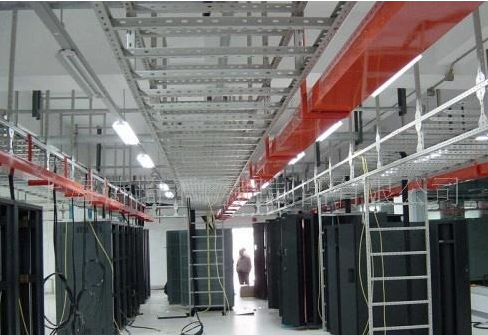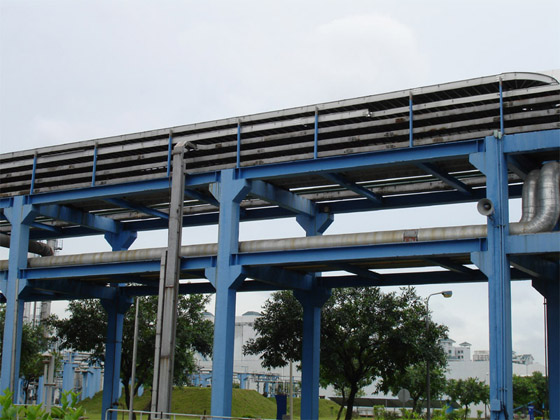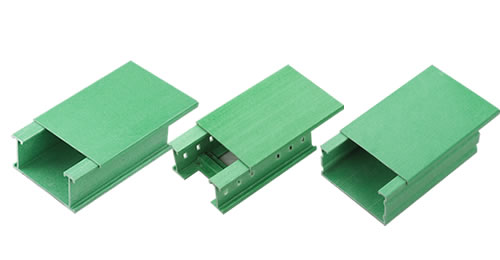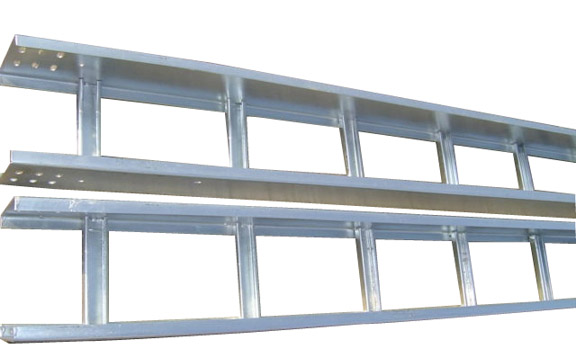強電磁干擾下電纜信號丟失,什么橋架能屏蔽干擾?
在5G基站、數據中心、工業控制等高頻電磁環境中,電纜信號完整性正面臨嚴峻挑戰。當電磁干擾強度超過3V/m時,普通電纜橋架內信號誤碼率呈指數級上升,甚引發數據鏈路中斷。電磁屏蔽橋架作為專項解決方案,通過材料科學與電磁場理論的深度融合,為關鍵信號傳輸構建起隱形防護屏障。
In high-frequency electromagnetic environments such as 5G base stations, data centers, and industrial controls, cable signal integrity is facing severe challenges. When the electromagnetic interference intensity exceeds 3V/m, the error rate of signals in ordinary cable trays increases exponentially, and even causes data link interruptions. As a specialized solution, electromagnetic shielding cable trays build invisible protective barriers for key signal transmission through the deep integration of material science and electromagnetic field theory.
一、電磁干擾的穿透機制與橋架防護原理
1、 The penetration mechanism of electromagnetic interference and the principle of bridge protection
電磁波對電纜的耦合干擾存在兩種路徑:空間輻射耦合與傳導耦合。當干擾頻率高于100kHz時,電磁波可通過橋架縫隙、孔洞產生趨膚效應,在電纜表面形成感應電流。實驗數據顯示,在1GHz頻段,普通鍍鋅橋架的屏蔽效能(SE)僅15dB,相當于允許93%的電磁能量穿透。
There are two paths of electromagnetic wave coupling interference on cables: spatial radiation coupling and conduction coupling. When the interference frequency is higher than 100kHz, electromagnetic waves can generate skin effect through bridge gaps and holes, forming induced currents on the surface of the cable. Experimental data shows that in the 1GHz frequency band, the shielding effectiveness (SE) of ordinary galvanized cable trays is only 15dB, which is equivalent to allowing 93% of electromagnetic energy to penetrate.
電磁屏蔽橋架的核心設計遵循法拉第籠原理,通過三重防護機制實現干擾阻隔:
The core design of the electromagnetic shielding bridge follows the Faraday cage principle and achieves interference blocking through a triple protection mechanism:
高導電性材料選擇:采用電解銅箔(導電率≥58MS/m)或不銹鋼基材,利用自由電子的快速移動中和入射電磁波。
Selection of high conductivity materials: electrolytic copper foil (conductivity ≥ 58MS/m) or stainless steel substrate is used to neutralize incident electromagnetic waves through the rapid movement of free electrons.
連續導電結構:通過激光焊接替代傳統鉚接,將橋架搭接電阻控制在0.1mΩ以下,電磁泄漏路徑。
Continuous conductive structure: By replacing traditional riveting with laser welding, the bridge overlap resistance is controlled below 0.1m Ω to eliminate electromagnetic leakage paths.
多層復合屏蔽:在金屬層內側噴涂鎳基涂層,形成趨膚深度<1μm的高阻抗層,針對性衰減高頻干擾。
Multi layer composite shielding: Spray a nickel based coating on the inside of the metal layer to form a high impedance layer with a skin depth of less than 1 μ m, which effectively attenuates high-frequency interference.
二、電磁屏蔽橋架的技術分類與性能邊界
2、 Technical classification and performance boundary of electromagnetic shielding cable tray
根據應用場景的電磁環境特征,電磁屏蔽橋架演進出三大技術路線:
According to the electromagnetic environment characteristics of the application scenario, there are three major technical routes for electromagnetic shielding cable trays:
雙層金屬屏蔽橋架
Double layer metal shielding bridge
采用內外層金屬結構,中間填充絕緣材料。外層選用冷軋鋼板(厚度≥1.5mm)抵御低頻磁場,內層使用銅箔(厚度≥0.2mm)吸收高頻輻射。該結構在30MHz-18GHz頻段可實現60dB以上的綜合屏蔽效能,適用于變電站、雷達站等強電磁環境。
Adopting an inner and outer metal structure, with insulation material filled in the middle. The outer layer is made of cold-rolled steel plate (thickness ≥ 1.5mm) to resist low-frequency magnetic fields, while the inner layer is made of copper foil (thickness ≥ 0.2mm) to absorb high-frequency radiation. This structure can achieve a comprehensive shielding efficiency of over 60dB in the 30MHz-18GHz frequency band, and is suitable for strong electromagnetic environments such as substations and radar stations.
復合材料屏蔽橋架
Composite material shielding bridge
將不銹鋼纖維(體積分數≥15%)與改性聚酯復合,通過三維編織工藝形成導電網絡。該材料在保持橋架輕量化的同時,實現30dB的屏蔽效能,且耐腐蝕性能優于傳統金屬橋架,特別適合沿海化工區域使用。
Composite stainless steel fibers (volume fraction ≥ 15%) with modified polyester to form a conductive network through three-dimensional weaving process. This material achieves a shielding efficiency of 30dB while maintaining the lightweight of the bridge frame, and its corrosion resistance is superior to traditional metal bridge frames, making it particularly suitable for use in coastal chemical areas.
波導通風型屏蔽橋架
Waveguide ventilation type shielding bridge
針對需要自然散熱的場景,開發出蜂窩狀六邊形孔結構。孔徑設計遵循波導截止原理,當孔洞尺寸小于干擾波長1/2時,電磁波無法穿透。實驗表明,在2.4GHz頻段,開孔率40%的波導橋架仍能保持50dB的屏蔽效能。
Developed a honeycomb hexagonal pore structure for scenarios that require natural heat dissipation. The aperture design follows the principle of waveguide cutoff. When the aperture size is less than half of the interference wavelength, electromagnetic waves cannot penetrate. Experiments have shown that in the 2.4GHz frequency band, a waveguide bridge with an aperture ratio of 40% can still maintain a shielding effectiveness of 50dB.

三、屏蔽效能的關鍵影響因素與優化方向
3、 Key influencing factors and optimization directions of shielding effectiveness
電磁屏蔽橋架的實際性能取決于三大要素:
The actual performance of electromagnetic shielding cable trays depends on three major factors:
接地系統設計
Earthing system design
需構建低阻抗接地網絡,接地電阻應≤0.1Ω。采用銅編織帶(截面積≥50mm2)連接橋架與接地母排,避免因接地不良導致屏蔽效能下降20dB以上。
A low impedance grounding network needs to be constructed, with a grounding resistance of ≤ 0.1 Ω. Use copper braided tape (cross-sectional area ≥ 50mm 2) to connect the bridge and grounding busbar, avoiding a decrease of more than 20dB in shielding effectiveness due to poor grounding.
縫隙處理工藝
Gap treatment process
橋架連接處應使用導電襯墊(如鈹銅指形簧片),壓縮量控制在30%-50%。模擬分析顯示,1mm寬的未處理縫隙可使屏蔽效能降低15dB。
Conductive pads (such as beryllium copper finger springs) should be used at the connection of the bridge, with compression controlled between 30% and 50%. Simulation analysis shows that a 1mm wide untreated gap can reduce shielding effectiveness by 15dB.
孔洞與開口優化
Optimization of Holes and Openings
對于必須開設的出線孔,應采用D型橡膠襯套,其內嵌金屬絲網可維持屏蔽連續性。經測試,該設計可使開口處的屏蔽衰減控制在3dB以內。
For the necessary outlet holes, D-type rubber bushings should be used, which are embedded with metal wire mesh to maintain shielding continuity. After testing, this design can control the shielding attenuation at the opening within 3dB.
四、新型電磁屏蔽橋架的技術前沿
4、 The technological forefront of new electromagnetic shielding cable trays
隨著材料科學的突破,電磁屏蔽橋架正朝著化、智能化方向發展:
With the breakthrough of materials science, electromagnetic shielding cable trays are developing towards high efficiency and intelligence:
納米晶合金應用
Application of nanocrystalline alloys
將Fe-Si-B基納米晶合金(厚度0.03mm)復合于橋架內壁,在1MHz-1GHz頻段實現80dB的屏蔽效能,且厚度僅為傳統銅箔的1/7。
Fe-Si-B based nanocrystalline alloy (thickness 0.03mm) was composite on the inner wall of the bridge, achieving a shielding efficiency of 80dB in the frequency range of 1MHz-1GHz, with a thickness only 1/7 of traditional copper foil.
自適應屏蔽系統
Adaptive shielding system
集成電磁場傳感器與可變電容陣列,通過實時檢測環境干擾強度,動態調節橋架屏蔽效能。該系統可使數據中心的電磁兼容性提升40%。
Integrating electromagnetic field sensors and variable capacitor arrays, dynamically adjusting the shielding effectiveness of bridge structures by detecting environmental interference intensity in real-time. This system can improve the electromagnetic compatibility of data centers by 40%.
石墨烯涂層技術
Graphene coating technology
在橋架表面噴涂石墨烯氧化物涂層,利用其二維導電網絡實現20dB的附加屏蔽,同時賦予橋架自清潔功能,降低維護成本30%。
Spraying graphene oxide coating on the surface of the bridge, utilizing its two-dimensional conductive network to achieve additional shielding of 20dB, while endowing the bridge with self-cleaning function, reducing maintenance costs by 30%.
電磁屏蔽橋架作為保障信號完整性的關鍵基礎設施,其技術演進正深刻影響著電磁敏感場景的工程建設。通過材料創新與結構優化,現代屏蔽橋架已能在強電磁干擾環境下,將信號丟失率控制在0.01%以下,為5G通信、智能電網等新基建領域提供可靠支撐。
As a key infrastructure for ensuring signal integrity, the technological evolution of electromagnetic shielding cable trays is profoundly affecting the engineering construction of electromagnetic sensitive scenarios. Through material innovation and structural optimization, modern shielded cable trays can control signal loss rates below 0.01% in strong electromagnetic interference environments, providing reliable support for new infrastructure fields such as 5G communication and smart grids.
本文由濟南電纜橋架友情奉獻.更多有關的知識請點擊:http://www.offroader.com.cn真誠的態度.為您提供為的服務.更多有關的知識我們將會陸續向大家奉獻.敬請期待.
This article is a friendly contribution from Jinan Cable Bridge For more information, please click: http://www.offroader.com.cn Sincere attitude To provide you with comprehensive services We will gradually contribute more relevant knowledge to everyone Coming soon.









